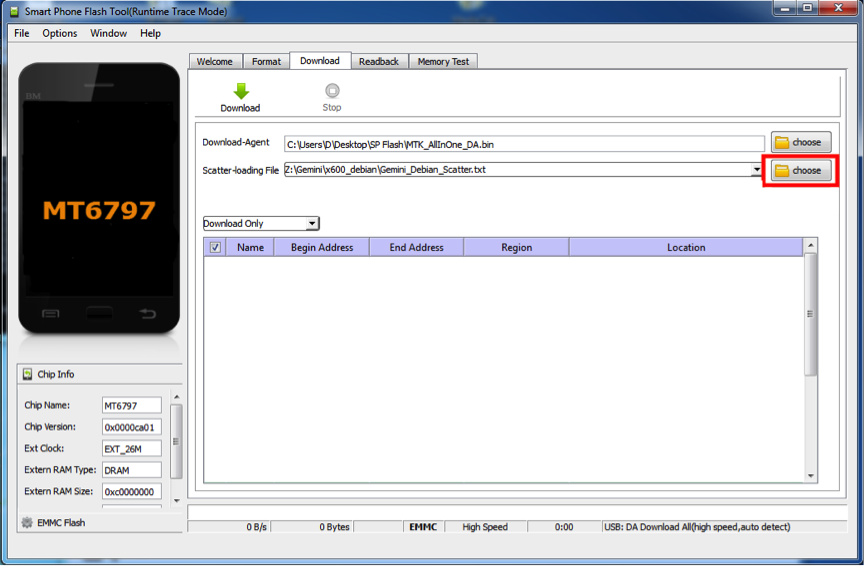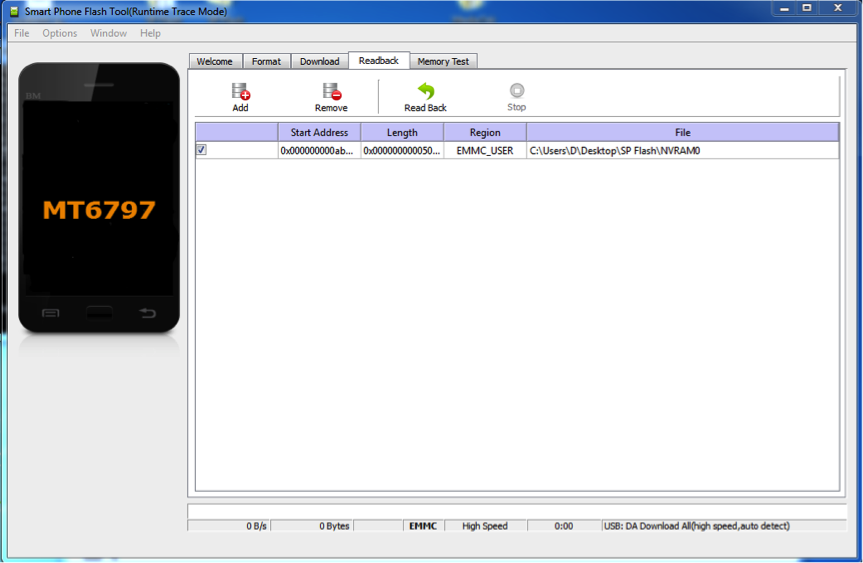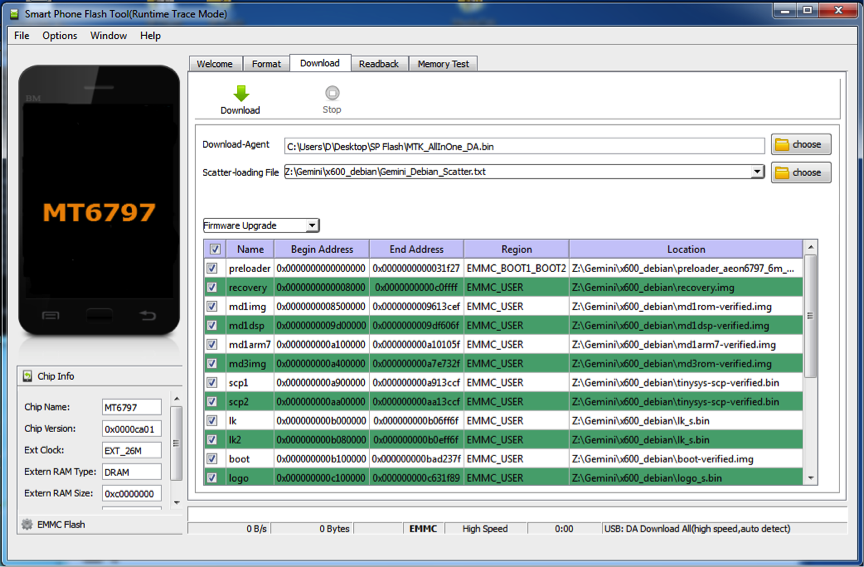Difference between revisions of "Linux Flash Guide"
From Planet Computers
(→No summary) |
(→No summary) |
||
| (11 intermediate revisions by the same user not shown) | |||
| Line 1: | Line 1: | ||
| + | ==Introduction== | ||
This document will guide you through the necessary steps needed to flash your Gemini with Linux or Android OS. | This document will guide you through the necessary steps needed to flash your Gemini with Linux or Android OS. | ||
| + | '''Please note: <span style="color: #ff0000;">Flashing Android or Linux will delete any user data on the device. Please make sure you have a backup of any important data before starting!</span>''' | ||
| − | + | <div style="text-align: justify;">'''Important Note: <span style="color: #ff0000;">please don’t use other tools to install Linux on a Gemini as it’s easy to loose key information such as IMEI. In particular, never use the “Format all + download“ option in the SP Flash Tool as this erases key information stored in the NVRAM partition and can lead to a non-functional device.</span>'''</div> | |
| − | <div style="text-align: justify;"> | ||
| Line 15: | Line 16: | ||
| − | Once downloaded, unzip the archive. You will find a folder called ''' | + | Once downloaded, unzip the archive. You will find a folder called '''FlashToolDrivers''', open the folder and double click on the '''Install''' file. Allow the installation to complete by clicking Yes when asked to make changes. |
| Line 23: | Line 24: | ||
| − | Once downloaded please unzip both the flash tool and the firmware. Next, run the flash tool by double clicking on '''flash_tool''' in the ''' | + | Once downloaded please unzip both the flash tool and the firmware. Next, run the flash tool by double clicking on '''flash_tool''' in the '''FlashTool''' folder. The software will initially complain that he cannot find the scatter file. Use the choose button as in the following screenshot to load the scatter file that you will find inside the downloaded firmware. |
| + | |||
| + | |||
| + | [[File:flash1.png]] | ||
| + | |||
| + | |||
| Line 50: | Line 56: | ||
Now, open the firmware folder from the firmware zip file you downloaded and select the scatter file. The table should be populated as below: | Now, open the firmware folder from the firmware zip file you downloaded and select the scatter file. The table should be populated as below: | ||
| + | |||
[[File:flash2.png]] | [[File:flash2.png]] | ||
| + | |||
Finally, change the '''Download Only''' drop down menu to''' Firmware Upgrade''' and click on the '''Download''' button. Connect your Gemini and restart it. . Once rebooted, the flash tool will detect the phone and it will update the OS with the selected firmware. | Finally, change the '''Download Only''' drop down menu to''' Firmware Upgrade''' and click on the '''Download''' button. Connect your Gemini and restart it. . Once rebooted, the flash tool will detect the phone and it will update the OS with the selected firmware. | ||
| Line 60: | Line 68: | ||
The dual boot mechanism works as follow: | The dual boot mechanism works as follow: | ||
| − | * If you restart | + | * If you restart your Gemini normally (i.e. no special key is pressed), then Android will start. |
| − | * | + | * To start in recovery mode, keep pressed the Esc (On) key until the screen turns ON. |
| − | * To boot Linux, | + | * To boot Linux, keep pressed the side button key until the screen turns ON. |
Latest revision as of 16:18, 16 March 2018
Contents
Introduction
This document will guide you through the necessary steps needed to flash your Gemini with Linux or Android OS.
Please note: Flashing Android or Linux will delete any user data on the device. Please make sure you have a backup of any important data before starting!
Download and install flash tool drivers
The first step is to install the flash tool drivers. These drivers are needed for your PC to communicate with your Gemini. At the moment the drivers are only available for Windows, they are also known to work inside a Windows virtual machine running on a different operating system.
You can find the drivers here: http://support.planetcom.co.uk/index.php/Linux_Support
Once downloaded, unzip the archive. You will find a folder called FlashToolDrivers, open the folder and double click on the Install file. Allow the installation to complete by clicking Yes when asked to make changes.
Download and install flash tool
Now that the drivers have been installed, we can download the flash tool. You will also need a firmware to flash, either Linux or Android. You can find the flash tool, alongside with the current available Linux versions here: http://support.planetcom.co.uk/index.php/Linux_Support
Once downloaded please unzip both the flash tool and the firmware. Next, run the flash tool by double clicking on flash_tool in the FlashTool folder. The software will initially complain that he cannot find the scatter file. Use the choose button as in the following screenshot to load the scatter file that you will find inside the downloaded firmware.
Backup the NVRAM partition
Before flashing the device with a different firmware it is a good idea to backup the current NVRAM partition. This partition stores key information for your Gemini, including the IMEI number. If it gets lost or damaged, your Gemini will not be able to take or receive calls.
The provided flash tool is already configured for your Gemini. To create a backup of your NVRAM partition, just click on the Readback tab and then on the Add button. A row will appear in the table as in the following screenshot.
Next, just click the Read Back button, connect your Gemini to your PC and restart the Gemini. Once rebooted, the flash tool will detect the phone and will write the NVRAM partition on a file on your hard disk called NVRAM0. It’s a good idea to keep this file as a backup.
Flashing the Gemini with an alternative firmware
Be sure to follow the previous step to store a copy of the NVRAM partition as backup. Now, run the Flash tool software and click on the Download tab. Next, locate the Scatter-loading File option and click on the associated choose button, as highlighted in the picture below:
Now, open the firmware folder from the firmware zip file you downloaded and select the scatter file. The table should be populated as below:
Finally, change the Download Only drop down menu to Firmware Upgrade and click on the Download button. Connect your Gemini and restart it. . Once rebooted, the flash tool will detect the phone and it will update the OS with the selected firmware.
Linux dual boot notes
The dual boot mechanism works as follow:
- If you restart your Gemini normally (i.e. no special key is pressed), then Android will start.
- To start in recovery mode, keep pressed the Esc (On) key until the screen turns ON.
- To boot Linux, keep pressed the side button key until the screen turns ON.




